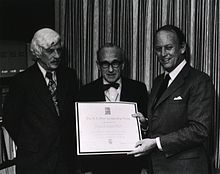Elvin A. Kabat
Elvin Abraham Kabat (born September 1, 1914 in New York City , † June 16, 2000 in Falmouth , Massachusetts ) was an American chemist and immunologist . From 1946 to 1985 he was a professor at Columbia University and his scientific work included the chemical nature and structure of antibodies , immunochemical studies on the AB0 antigens and studies on experimental autoimmune encephalomyelitis . In recognition of his achievements, he was accepted into the National Academy of Sciences and the American Academy of Arts and Sciences in 1966, and was awarded the Louisa Gross Horwitz Prize in 1977 and the National Medal of Science in 1991 .
Life
Elvin Kabat was born in New York City in 1914 and graduated from high school at the age of 15 . He then began studying at City College of New York , graduating in 1932 with a BS degree specializing in chemistry . He then moved to Michael Heidelberger's laboratory at Columbia University , where he obtained an MA in 1934 . In 1937 he was in Michael Heidelberger with the work The reaction between crystalline horse serum albumin and antibody FORMED in the rabbit doctorate . As a post-doctoral student , he then worked temporarily with The Svedberg and Arne Tiselius at Uppsala University.
In 1938 he was hired as a lecturer in pathology at Cornell University . Three years later he moved to Columbia University, where he initially worked as a research assistant, before he was Professor of Bacteriology from 1946 to 1952 , Professor of Microbiology from 1952 to 1985 and, from 1969, also Professor of Human Genetics and Developmental Biology worked. His students included Stuart F. Schlossman and the later Nobel Prize winner Baruj Benacerraf .
Elvin Kabat was married from 1942 and had three sons, of whom Jon Kabat-Zinn was a professor at the University of Massachusetts and became known for his work on dealing with stress and anxiety , and six daughters. He died in Falmouth, Massachusetts in 2000 .
Scientific work
Elvin Kabat, who has published around 470 scientific publications in 65 years , devoted himself to various aspects of immunological research, and with his work made fundamental contributions to the understanding of inflammatory processes and allergies as well as to transfusion medicine . Together with his doctoral supervisor Michael Heidelberger, he was able to use electrophoresis and ultracentrifugation to show that antibodies are the gamma fraction of the globulins present in the serum . Based on the molecular mass and the sedimentation rate , they also managed to distinguish two different types of antibodies, which were later referred to as the immunoglobulin classes IgG and IgM . Together with Manfred M. Mayer , another student of Michael Heidelberger, he published the textbook Experimental Immunochemistry , which appeared in two editions and seven reprints between 1948 and 1984.
In addition, together with Michael Heidelberger, he investigated the precipitin reaction and the effect of agglutinins . After the end of the Second World War , he worked, among other things, on immunochemical studies on the AB0 antigens , on experimental autoimmune encephalomyelitis in monkeys as a model disease for multiple sclerosis in humans and on immune reactions against the substance dextran, which is used as a blood substitute . Based on his investigations into the interactions between dextran and anti-dextran antibodies, he was able for the first time to estimate the minimum and maximum size as well as the spatial shape of the antigen binding sites of antibodies. These data were later confirmed by other scientists through crystallographic work on the three-dimensional structure of antibodies.
Awards
Elvin Kabat served as President of the American Association of Immunologists in 1965/1966 and was inducted into both the National Academy of Sciences and the American Academy of Arts and Sciences in 1966. He received honorary doctorates from the Weizmann Institute for Science (1982), Columbia University (1987) and Northwestern University (1994), as well as the Eli Lilly and Company Research Award in 1949 , the Karl Landsteiner Memorial Award in 1966 , and in 1977 Louisa Gross Horwitz Prize , the Philip Levine Award in 1982 , the Dickson Prize in Medicine in 1987 , the National Medal of Science in 1991 and the Lifetime Achievement and Lifetime Service Award from the American Immunologists Association in 1995 . Named after Elvin Kabat, the Heidelberger-Kabat Distinguished Lectureship in Immunology at Columbia University has been awarded annually since 2001 .
Works (selection)
- Blood Group Substances. Their Chemistry and Immunochemistry. New York 1956
- Experimental Immunochemistry. Springfield, IL 1948, 1958, 1961, 1964, 1967, 1971 (Czech edition: Experimentálni imunochemie , Prague 1965; Spanish edition: Inmunoquímica experimental , Mexico City 1968)
- Structural Concepts in Immunology and Immunochemistry. New York 1968, 1976
- Introduction to Immunochemistry and Immunology. Berlin 1971
literature
- Rose G. Mage, Ten Feizi: Elvin A. Kabat. September 1, 1914 − June 16, 2000. In: Biographical Memoirs. Volume 85. National Academy of Sciences, Washington DC 2004, ISBN 0-309-10363-0 , pp. 98-123 (with picture and selected bibliography)
- Donald M. Marcus, Stuart F. Schlossman: In Memoriam: Elvin Abraham Kabat. September 1, 1914-June 16, 2000. In: Journal of Immunology. 166/2001. American Association of Immunologists , pp. 3635/3636, ISSN 0022-1767
- William E. Paul, Rose G. Mage: Obituary: Elvin A. Kabat (1914-2000). In: Nature . Volume 407. Edition 6802 from September 21, 2000, p. 316
Individual evidence
- ^ Biographical data, publications and academic family tree of Elvin A. Kabat at academictree.org, accessed on February 15, 2018.
| personal data | |
|---|---|
| SURNAME | Kabat, Elvin A. |
| ALTERNATIVE NAMES | Kabat, Elvin Abraham (full name) |
| BRIEF DESCRIPTION | American chemist and immunologist |
| DATE OF BIRTH | September 1, 1914 |
| PLACE OF BIRTH | New York City |
| DATE OF DEATH | June 16, 2000 |
| Place of death | Falmouth, Massachusetts |
